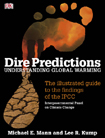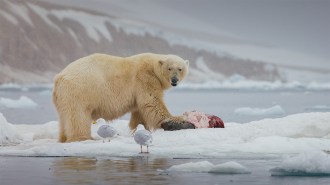IPCC Lite
Last year, the Intergovernmental Panel on Climate Change issued a trio of paperback books that reviewed the latest science about our evolving climate, the apparent causes for its recent warming trend, and the likely consequences. The hundreds of scientists who collaborated on these reports hoped to bolster their argument for transitioning away from reliance on fossil fuels by serving up compelling details.

Their noble effort, however, resulted in tomes that together tip the scales at 17.5 pounds, run 2,844 pages and will set you back more than $225 even if you purchase them at that big discount online book seller. Moreover, this package of reports is dismally gray. Lots of text, graphs, and tables — with only the occasional drawings of a globe streaked with vibrant color to suggest temperature projections.
Two PennState climate scientists have now distilled all of this into an easy, breezy — but scientifically “authoritative” — 200-page gorgeously illustrated book. It retails for $25 but can be purchased through discount outlets for substantially less.
Which would you prefer to wade through?
Actually, climate scientist Michael Mann, who directs PennState’s EarthSystemScienceCenter, probably doesn’t care whether you read the IPCC set or his new book — as long as you read at least one. The problem is, he knew people weren’t running out in droves to grab those big-city-phonebook sized IPCC reports or even downloading select chapters to read online. Moreover, he notes, “Aside from the summary for policymakers, which is very terse, there doesn’t exist any vehicle for taking all of the vital information in this lengthy, and sometimes very technical set of reports, and boiling it down for popular consumption.”
So when his colleague, geoscientist Lee R. Kump, suggested they team up to write a book popularizing Earth sciences, a year ago — just after the IPCC books’ unveiling — they agreed to work on extracting the essence of the new climate tomes, and then making it accessible.
Their target audience: the not-so-science-literate public, college undergraduates — and oh, who knows, maybe federal policymakers. “We wanted to translate [the IPCC package] in a way that a person on the street, without a technical background, could really understand the issues involved.”
Last week, DK Publishing issued their book. It’s titled “Dire Predictions.” The publisher is renowned for putting out gorgeous books (I drool over those developed for gardeners, for instance, while my daughter prefers the ones on animals). The PennState pair liked the idea of working with DK’s “information architects.” Explains Mann, these are people “who find a way who take information — graphs, tables, what have you — and try to bring these data alive” through drawings or photos.
“We came up with concepts we wanted to explain to a lay audience,” he says, “such as ‘fingerprint detection:’ how we can look at patterns of temperature change during the 20th century — not just the fact that temperatures are warming — but the spatial pattern of warming that points to the source of that warming.”
For instance, at ground level, the global warming due to an increase in the sun’s energy looks much the same as one due to an atmospheric buildup of greenhouse gases. Indeed, Mann says, “we might not be able to tell one from the other if all we had were surface observations. But that’s not all we have.” Weather balloons, satellites and other sources of information have mapped temperatures up through the skies.
And this allows scientists to find key indicators of the source of warming. A solar warming should lead to a warming throughout the atmosphere, Mann explains. “Instead, what we’re finding is a warming in the troposphere, the lower part of the atmosphere that we live in, but a cooling as you move up into the lower stratosphere where jets fly. And that cooling aloft,” he says, “is a unique signature of a warming due to increased greenhouse-gas concentrations.”
This is the type of conceptual material covered in his new book. And it’s a pretty book, which is not by accident.
“We wanted it to be so attractive — so engaging — that people will want to read it, and in so doing learn about the science,” Mann says. Because to be able to understand the climate system, “we have to talk about geology, Earth’s history, some chemistry, even biology. And in the process we’ll actually be educating people about a broader range of underlying scientific issues — without shying away from some fairly complicated scientific topics.”
I asked Mann: Might one think of this as An Inconvenient Truth, Pt. 2?
“Obviously, there is some overlap between Al Gore’s book and ours,” Mann says. “But Gore’s book wasn’t written by scientists. And it reads like it wasn’t. While I do think [An Inconvenient Truth] was wonderful,” he says it lacks the authoritativeness of one written by climate scientists. “So when readers see something in our book,” Mann says, “they can know we’ve gotten even the details right” — that this is how the climate-science community is interpreting the latest data.
The new book is also upbeat. He and Kump “talked quite a bit about a need for that,” Mann says. They decided to lay out the science and the potentially “dire” risks to the planet and its inhabitants if energy-use policies don’t change. But “we do think this [climate dilemma] is something that we can solve.” And it’s important to point that out, he says, so that the public doesn’t despair and decide there’s no reason to begin making the hard choices that will lower the planet’s growing fever.
For all these apparent endorsements, I should point out that the new book is not without its flaws. Many of the topics it addresses could use more detail (even if only a few sentences more). I’ve found instances too where the language is vague. Not incorrect. Just not as clear as most science writers would strive for. A prime case in point: the section on carbon-isotope fingerprints for sources of the CO2 buildup in Earth’s atmosphere.
But overall, the authors have tackled a tough job and given lay readers a nice primer to begin wading into the complexities of Earth’s climate.
Those who want more details on topics addressed in the book, along with interpretations of research findings as they emerge, might also want to check out a blog site that Mann and some of his climatology cronies have developed: www.realclimate.org.






